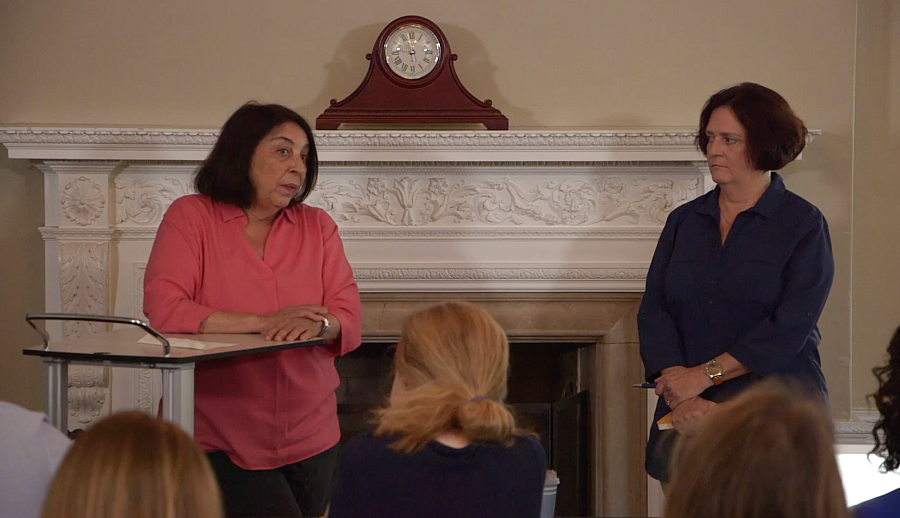Six tips for boosting your public records reporting from a master practitioner

Veteran reporters and journalism professors Sarah Cohen and Cheryl Phillips play the roles of reluctant bureaucrat fending off a reporter seeking government records at the 2019 Data Fellowhsip last week.
(Image by Jeff Skeirik/CHJ)
Veteran journalist Sarah Cohen, a public records wizard who spent most of her career at The New York Times and The Washington Post, likes to talk about the power of “reporting from the outside in.”
“The idea is that you start gathering some string, you start talking to people who might be affected by a system, and before you get to anyone in the government, you know way more than they do,” Cohen told a room full of reporters and editors at the 2019 Data Fellowship last week. “That’s the goal: You never ask a question from the government that you don’t already know the answer to.”
Katherine Boo, Cohen’s former colleague at The Post, was reportedly a master at this technique. In Cohen’s telling, the legendary reporter once told a stonewalling D.C. bureaucrat precisely which building, room and box held the death records she was seeking, suddenly rendering the agency’s denials implausible.
“Our job is to figure out before we even start which artifacts exist,” Cohen said. Doing so makes it much harder for agencies to claim they don’t.
So how do you figure out exactly which databases and records you should be submitting FOIA requests, particularly when you’re stuck on the outside looking in? Here are a few key tips from Cohen’s quick master class in public records reporting:
1) Know the law: Before you start, learn your state’s laws on public records. Nearly every state has a guide to public records laws, whether it’s from the legislature, press association or other group. Here’s one for California, for instance. The Reporters Committee for Freedom of the Press also has a very useful Open Government Guide, with breakdowns of every state’s public records laws, detailing what’s public and what’s not.
2) Order from the menu: Cohen points out that you wouldn’t go to a restaurant and say, “I’d like some food, please.” Instead, you’d peruse the menu and order, say, a Cobb salad. The same applies with public records: While you’re unlikely to get very far requesting a state agency’s records on infectious diseases, you’re much more likely to strike gold if you already know you’re seeking six fields from form B24067, collected by the state’s department of public health, for instance.
“Suddenly they can’t tell you it doesn’t exist, because you know they have it,” she said, stressing the importance of doing enough pre-reporting to know exactly what you want on the governmental “menu.”
3) Spelunking for treasure: This is where falling down a few late-night rabbit holes on state websites and site indexes can pay dividends. The goal is to get off the main road: Cohen scoffs at the categories government landing pages try to herd visitors into. She likens government-run open-data portals to “propaganda sites.” You’re better off wandering the backroads (check out at all these agencies for California alone). Such agencies are potential mother lodes of forms and records that can then be requested — if you do your homework, pick the right agency and know what to ask for.
4) Paper has a purpose: “Look at the form itself,” Cohen says. “A lot of times people will fill out the form online but, in most cases, they’ll still have a paper version floating around.” That paper version of a typical form will present a condensed representation of all the data fields that are being collected, and it will allow you to tailor your request to include those specific fields.
5) See what other places did: For one project, Cohen discovered Tempe, Arizona had published a list of all EMS calls involving opioid overdoses, but Phoenix had not. It was a tip off that other places in the state were required to track this data, even if they didn’t disclose it, and that her team could use that newfound knowledge to request records from other cities. Her broader point is that municipalities don’t tend to invent practices like this from scratch — they’re part of broader standards, trends or protocols shared among governments. Find one and you’ll likely find others.
6) Save energy, draft behind others: “The mother of all sources for reporters is other people’s FOIAs,” Cohen said, adding that reporters only make up about 2% of public records requests. The rest largely are made up by businesses doing investigations on their competitions, stakeholder seeking records on their issue or area, those seeking material for lawsuits, and so forth. The common thread? They likely know far more than you do about how the agency works, which records it keeps and what they mean.
“Finding someone who is obsessed with your agency or your topic and finding out what they would request is a really important thing to do,” said Cohen.
Read more about Sarah Cohen’s FOIA strategies here.

